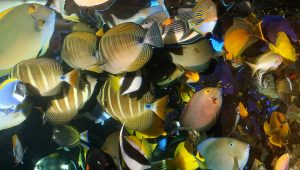
If you want to see a whole lot of surgeonfishes in one tank stop by Atlantis Aquarium on Long Island and see Joe Yaiullo’s gigantic reef. It’s big enough to get away with keeping a mix of just about everything, and the most impressive indoor reef I’ve ever seen.
Some of the most popular fishes in the marine aquarium hobby are the surgeonfishes, all of which are in the Family Acanthuridae. Commonly known as tangs, many are very attractive, have unique personalities, and will also help keep your tank clean. However, when it comes to hardiness they’re oftentimes sub-par, some can be quite aggressive, and some get too big for any but the largest home aquariums. Thus, it’s important to know a little about any particular species of surgeonfish before making a decision to take one home. I’ll fill you in on the group as a whole, and then give a bit of specific info about each of the species you’re most likely to see offered for sale to help make things easier if you’re thinking about getting one.
General Information
Surgeonfishes are a good-looking bunch for the most part, with only a few species that aren’t nicely colored or at least covered with some sort of neat patterning. The pictures make that easy to see, of course, but being pretty is nothing particularly special when it comes to marine fishes. However, many surgeons stand apart from other fishes because of their personalities, which is one of the things I’ve always liked most about them. Like dogs that become obviously excited to see their human come home, various surgeons are often the first fishes to dart to the front pane of glass and dance around when you enter the room, even when many other fishes seem oblivious to your presence. To tell the truth, if I’ve ever seen a fish look genuinely happy to see me, it would have to be a surgeon. Many of them really do remind me of little aquatic dogs with their attitudes and antics.
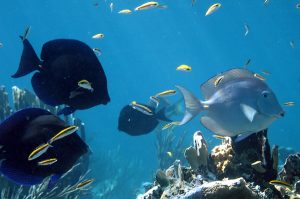
Note that surgeonfishes often change colors to some degree, and can get much lighter or darker at times. It’s quite common for them to lighten considerably at night over their whole body, but even during the day individuals of some species can look very different. Here you can see both dark and light-colored Atlantic blue tangs, all of which are apparently healthy.
Surgeons are also about as invertebrate-safe as a family of fishes can be. After running an aquarium maintenance business for 5 years and being in the hobby for almost twenty, I can recall only a single one of these fishes becoming a problem for corals/reef aquarium critters (see the specifics for clown tangs below). Still, there are a couple of things to bring up.
First, while working on my book about giant clams, I came across a few stories concerning surgeons and tridacnids. Apparently, an occasional surgeon will become fond of slurping mucous from the fleshy, extended mantle tissue of a giant clam. They don’t actually bite the clam, but they can kill it nonetheless. The problem is that the clam will usually jerk in its mantle and pull the shell closed in reaction to being slurped on, which can wear out and stress it severely if it does it over and over. If a fish is persistent, this can actually lead to reduced heath of the clam, or even death. Still, again, I’ve never seen anything like this myself, and I’ve been keeping surgeons and clams together for the better part of two decades in my own tanks and those of past customers.
Second, Michael (2001) notes that when underfed, various tangs may begin to nip at large-polyped stony corals. I’ve never seen any such thing, but I feed my fishes well, so I wouldn’t expect to. I recon if you’re underfeeding your fishes and they start working on the corals, then that’s your fault. I certainly would not consider this to be “normal” behavior for any surgeonfish.

The surgeonfish name comes from the blade-like structures found near their tails. There are one or two of these on each side of the tail area, although they’re much smaller on some species than others. Some can also fold flush with the body, like little switchblade knives, while others are in a fixed position. When annoyed, rather than nibbling or biting each other, two surgeons will slap each other repeatedly with their tails and with their little scalpels. They may stick/cut each other, but the damage is typically light and not life-threatening.
Speaking of feeding… Surgeons love to eat, so feed them appropriate foods and feed them often. All of them are herbivores, and will eat a variety of plant and plant-based foods, but most all of them will also learn to eat other foods as well. Different species, and even individuals, do have variable diets though, and some will eat some things that others won’t look at.
A diet of foods like algae-packed cubes, Spirulina or other quality marine flakes, Gracilaria, nori (sushi wrap made of seaweed), and kombu (dried kelp) is best, and they’ll usually tear this stuff up and eat until they look like they’d burst if given the opportunity. Do make sure to buy unseasoned/untreated types if you get nori/kombu at the grocery though, as you don’t want to add any sorts of additives, preservatives, etc. Of course, surgeons will also find some food for themselves in most tanks, as well, as they’ll graze over glass and rock surfaces picking at whatever grows there. If you aren’t having a very, very serious algae problem, this won’t be enough to keep the healthy, though. Thus, you should feed them daily at the very least, and two or three times daily if possible. In the wild they poke around all day nibbling here and there, so as is the case with most herbivorous fishes, eating one big meal a day (or even less frequently) is not what they are used to at all.
Most will also eat lettuce, spinach, broccoli, and other greens. However, even though they’ll eat these very non-marine foods, their nutritional values are questionable. This is especially so for romaine lettuce, which is very commonly used to feed them. If frozen or boiled first and then added to an aquarium it gets very soft and most tangs will gobble it up. But, they may eat it, and eat it, and eat it, and gain little, if any weight. Thus, it’s probably much better to either not bother with this stuff, or to use it as part of a mixed diet. The other veggies should also only be part of a mixed-diet, as well. In addition, almost without exception, they’ll become omnivorous and will eat brine shrimp, copepods, mysid shrimp, bits of chopped clam and regular shrimp, and other sorts of meaty things, too. But, the same goes here once again. These are not what a tang relies on in the wild, so they should not be the only foods given in aquariums.
I’ve got an odd story for you too, on the subject of feeding. Many, many years ago I had a tank that housed a yellow tang, a few damsels, a couple of clowns, and an extra-large carpet anemone (Stichodactyla haddoni). I also had a creek right next to my apartment at the time, and I used to go net up a bunch of little minnows and feed them to the anemone, which helped it grow to a relatively huge size (20+ inches). After doing this for a while, much to my surprise, the tang took a liking to the minnows, too. Seriously! I’d throw in a few tiny minnows and the tang would always chase one or two down and gobble them up. Of course, it never bothered anything else in the tank, and it lived and ate with the anemone for around 4 years. Then, it apparently strayed too close to the carpet one night and met its demise. A sad ending for one of the first marine fishes I ever owned.
Do note that I only used these freshwater fishes for feeding the anemone, and did not intend for my tang to get them. Freshwater fishes can be detrimental to the long-term health of carnivorous fishes when eaten in quantity (see Toonen 2003 for more), but the anemone loved them.
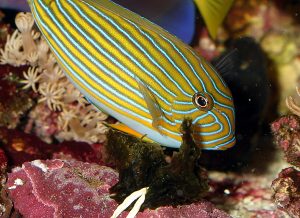
If you do feed nori, or anything else leafy, you can use a specialty clip that will hold the food and can then be affixed to the glass with a suction cup. They’re cheap and they work. Or, you can tie a piece of fishing line to a small rock, rubber band the food on top and plop it in. Then it’ll sit on the bottom where the fish will dine, and when feeding time comes again, you can pull it out by the string without getting wet.
Now it’s time for some bad news. As mentioned, surgeons don’t tend to be particularly hardy, at least not at first. Many do not fare well during collection and shipping, but that’s not all. A few can also be rather picky eaters that have a hard time staying healthy, and again, many seem to have immune systems that are sub-par. When disease strikes many are typically the first to show symptoms, and they’re particularly prone to catching cases of the two most deadly maladies around, saltwater ich (Cryptocaryon) and velvet (Amyloodinium). These are both difficult to spot, especially on brightly-colored tangs, and are also difficult to treat. They’ll essentially always lead to a relatively quick death of infected fishes if left untreated, as well. And trust me, if either of these gets into your tank, the tangs will get it.
There are other diseases, too, but of note are fin rot and head and lateral line erosion (HLLE). Tangs are also particularly prone to come down with either or both of these. However, unlike ich and velvet, both of these are easy to see, and neither leads to a quick death. Fin rot can be treated effectively, but HLLE is still quite a mystery, with many ideas about causes and effective cures. But, these are things for you to learn about somewhere else. Just be aware that if you buy a surgeonfish, you’ll need to be extra vigilant when it comes to disease prevention and treatment.
With this in mind, I strongly recommend that you give any surgeonfish a full-term quarantine in a dedicated aquarium. Running a separate quarantine tank can be a hassle and cost a few extra dollars, but it has been shown to be worth it time and time again. The same goes for other fishes and creatures too, for that matter. Always remember that the best way to keep your fishes from catching ich or velvet, etc. is to never allow these things to make it into your main aquarium in the first place.
If you make sure to choose healthy specimens at the store, acclimate them properly, quarantine them first, and maintain great water quality, these same fishes can be quite hardy though, and most all of them can adapt well to aquarium life. So, don’t think that they should be avoided. The fact is, most of them make great aquarium fishes (like I already said) when things are done right, and if they make it through the first few weeks, they’ll likely be with you for many years.
The next thing to cover is their tendency to not get along with each other. Surgeonfishes are safe with invertebrates and most (but not all) will get along just fine with other types of reef-safe fishes, as well. However, in general, they don’t care much for other surgeons. While many live in schools in the wild, trying to keep two or three of the same species in one tank will usually lead to trouble. Still, if the tank is big enough and several tangs of similar size are added simultaneously, their schooling nature just might override their fighting spirit and they may be okay with each other.
To make matters worse, even trying to keep different species of surgeons together can be problematic, too. Oftentimes it’s possible to keep two surgeons from different genera together, such as a yellow tang (Zebrasoma) and a kole tang (Ctenochaetus), but even this may not work. This is especially so if they’re not added at the same time and/or are different sizes.
If you want to have more than one, my advice is to choose specimens that don’t look much alike (and belong to different genera if possible), that are roughly the same size, and to add them at the same time to a tank with plenty of room. When doing so, I’ve been able to mix up quite a few of them without too much trouble. Still, they may chase each other at times and flap their tails around at each other, but not to the point that it affects their health/well being. This can be highly dependent on the particular species chosen, of course.
There are some surgeons that can be downright nasty even to other sorts of fishes, though. They can chase, bite, beat, stick, and basically pester other fishes literally to their death at times, and no amount of food and/or space will stop them. This kind of behavior is seen in some species more than others, but I assure you that even the most mild-mannered species may include an occasional bad-boy that decides to beat the tar out of everyone else in a tank. Sometimes this can be bad enough that you must either take the offensive surgeon out or end up with a one-fish aquarium. Or, end up adding something even bigger and meaner to give the brute a dose of its own medicine (not what I recommend, of course).
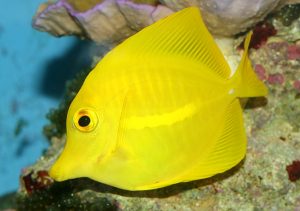
Yellow Tang, Zebrasoma flavescens: An all-time ubiquitous favorite of the marine aquarium hobby, yellow tangs are about as brightly-colored as a fish can get. They’re also relatively small, with a maximum size of just under 8 inches, and generally don’t cause any troubles in aquariums. Here again, I say generally because a few oddballs have been absolute jerks to other similar fishes.
Note that this sort of behavior can obviously be brought out when mixing the wrong fishes together, but unfortunately it can also occur when you’ve done everything right and made careful choices when stocking. I wouldn’t say over-aggression is common, but then I wouldn’t say it’s really rare either. So, be warned. It can happen to you (and your other fishes).
Some species are more aggressive than others on the whole and can simply be avoided if you’re concerned, but the real problem is the variability seen amongst individuals of the same species. Over the years I’ve found that the more behaviorally-boring a particular species of fish is, the more predictable their behavior tends to be. Likewise, those species that generally have real personality also tend to have a broader range of behaviors in aquariums. So, while I may praise surgeons for having plenty of personality, this also means that they can sometimes be quite unpredictable. In other words, if I tell you that yellow tangs tend to be quite peaceful and seemingly happy fish, you might have bad enough luck to get one that’s just plain boring or mean as can be. Chances are good that you won’t, but you might. Frankly, this shouldn’t be anything new to anyone that’s been keeping fish for long, and it certainly isn’t unique to surgeons. Likewise, it makes good sense that the size of the tank they’re placed in and who they’re kept with will also have an effect on the behavior of these. So, again, they’re behavior can vary from individual to individual in different aquariums.
Species Specifics
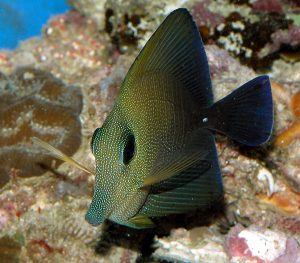
Scopas Tang, Zebrasoma scopas: Also called the brown tang, these are also relatively small, with a max size under 8 inches. They aren’t brightly-colored by any means, but they have beautiful details that make them attractive nonetheless. Oddly enough, while I’d say these have been quite friendly and relatively tame in aquariums (I’ve had at least a dozen), Michael (2001) says this is one of the most aggressive and highly territorial of the bunch. While I tend to agree with essentially everything Scott Michael writes, I do disagree with this entirely. It happens…
Okay, I’ve mustered some information from various sources and mixed it with personal experience to give you a bit about the species you’re most likely to see for sale. There are way too many tangs to give much detail about each species though, so you should do some more in-depth homework on a particular one if you think you want it. There are two things to note before moving on, though. I’ve given some maximum size numbers for these tangs, which can be found in Michael (2001) or at Fishbase.org, but specimens may not get nearly this big in an aquarium. These are maximum sizes, and any given specimen won’t likely reach it, even if well fed and kept in a big tank. They simply have the potential to reach such a size, although most will likely stay at two-thirds their maximum reported size, or smaller. Also, don’t forget what I just said about occasional nasty attitudes. When I say a tang is generally peacefully or aggressive towards other types of fishes, that means generally – not always. You should also assume that, unless stated otherwise, none of these is very likely to get along with other individuals of the same or similar species.
With that said, it’s widely agreed upon that the Pacific sailfin is one of the most peaceful tangs available, but they can also get too big for most folks. These fish can reach a maximum length of 16 inches, and I’ve actually seen one about that big in a tank in Japan. It was HUGE, like the size of a pizza! Again, it’s highly unlikely that one you might buy will grow so large, but even if it hits a foot, it would need quite a tank to stay happy.
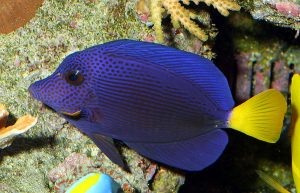
Purple Tang, Zebrasoma xanthurum: These may get a little bigger than the yellow or scopas tangs, possibly reaching almost 10 inches. They also tend to be much more aggressive towards other fishes and other tangs in particular. So much so that many hobbyists don’t like them, regardless of their regal colors. They’re typically relatively expensive, too.

Pacific Sailfin Tang, Zebrasoma veliferum: According to WetWebMedia.com, some folks say there are two sailfin tangs, the Pacific or “regular” sailfin (Z. veliferum) and the Red Sea/Indian Ocean sailfin (Z. desjardinii), while others say they’re just different-looking members of the same species, Z. veliferum. I’m no taxonomist and after a good bit of searching I never got a definitive answer, so I choose to keep them separate.

Red Sea Sailfin Tang, Zebrasoma desjardinii: Also called the Indian Ocean sailfin, this species can also reach 16 inches, and is also considered to be an especially peaceful fish. While they may sometimes look essentially identical to the Pacific sailfin, especially when small, specimens of this species always have spots on their tails, and typically have less defined banding on the body, usually being covered by thin stripes instead.
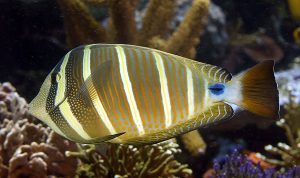
Some sailfins make it easy to see why these are considered to be the same species by some. This one lacks spots, so it must be Z. veliferum, but other than that it sure does look like something right between the species.
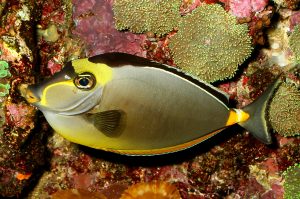
Naso Tang, Naso lituratus: Also known as the lipstick tang for its big red lips, these can get especially big with a full size of 18 inches or so, and may also grow long streamers from their tail fin. They’re generally very attractive and non-aggressive, but they’re really too big for the average aquarium (or will be). Apparently nasos can also be picky when it comes to food, as they sometimes refuse to eat anything other than macroalgae.
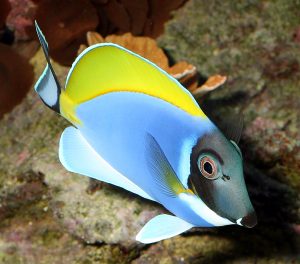
Powder Blue Tang, Acanthurus leucosternon: This gorgeous tang is another one of my favorites, although they’re known for not being very hardy and often do not fare well during the collection/shipping process. If you can get a healthy one, they’re great though, and have a maximum size of about 9 inches. I haven’t found them to be particularly aggressive towards other fishes, either.

White Cheek Tang, Acanthurus nigricans: There’s a never-ending mix-up with the name of this tang, as it’s also often called the powder brown tang or gold rimmed tang. The powder brown looks a lot like it, but is actually a different species altogether, thus the name really shouldn’t be used. Powder browns are A. japonicus (see below). Anyway, these are yet another great looking tang, with different colors, but a very similar pattern to the powder blue tang. They also max out at a little over 8 inches, and generally are not aggressive.
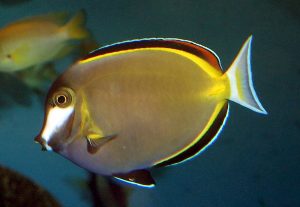
Powder Brown Tang, Acanthurus japonicus: The powder brown tang also reaches a maximum size of a little over 8 inches and is a relatively peaceful species, too. However, for reasons unknown, these tend to be less hardy than the white cheek tang. They’ve also been known to be pickier eaters, so you’re better off choosing the white cheek if you like the look of these fishes. If you have trouble telling them apart, note that the white cheek tang has a small patch of white under its eyes, but the powder brown tang has much larger white areas that cover most of its face.
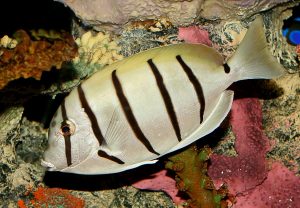
Convict Tang, Acanthurus triostegus: This species can reach a maximum size of just over 10 inches, but they’re probably the most peaceful of the tangs. So peaceful in fact, that it’s usually okay to add more than one to a tank. In really big tanks, a small school of these can be great too, but they’ll get big eventually. If there’s anything negative to say about them, it’s that they really aren’t particularly attractive, being rather dull in color.

Clown Tang, Acanthurus lineatus: This is a great-looking tang for sure, but it’s also one of the most aggressive of the lot. They’re well known for harassing and even attacking all sorts of other fishes, not just other tangs. They can also grow up to 15 inches in length, so they’re not for everyone by any means. This is also the only tang that I have ever witnessed biting corals, despite being well-fed and apparently perfectly healthy. And, as if that’s not enough, they aren’t the hardiest of tangs, either, often coming in as small sickly looking specimens. Get the picture?
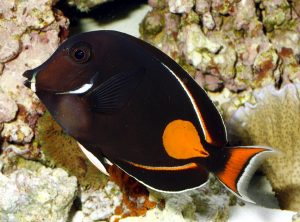
Achilles Tang, Acanthurus achilles: For a fish that’s mostly dark brown to black, these are somehow still quite beautiful and can grow to a bit over 9 inches. Unfortunately, opinions vary when it comes to their aggressiveness though (many are and many aren’t), and they’re also some of the least hardy of the tangs in my experience. They’re often emaciated upon arrival, and can be relatively picky eaters too, making recovery difficult. There are good ones though, so keep your eyes open and be patient if you want one.


Atlantic Blue Tang, Acanthurus coeruleus: This is probably the only tang you’ll ever see for sale that comes from the Atlantic/Caribbean. They can make it to just over 9 inches and adults are light to dark blue in color, while the juveniles are bright yellow with a blue ring around their eyes. Adolescents are the most common ones for sale, which have already turned mostly blue, but still have a yellow tail. They’re generally peaceful unless kept in an undersized aquarium, and can even be kept in small groups if housed in a large tank.

Orange Shoulder Tang, Acanthurus olivaceus: This is another big guy that can make it to well over a foot, with a maximum length of about 14 inches. And, like a few other tangs, the juveniles are bright yellow in color, which grades into the adult coloration as they grow. Unfortunately, opinions are again mixed when it comes to how aggressive these can be, which means they are generally unpredictable. Some can be very aggressive, but some may never pay any attention to other fishes at all.
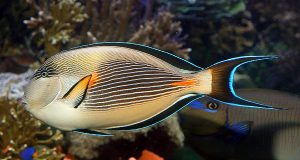
Sohal Tang, Acanthurus sohal: If I have to pick a single most aggressive species, it’s this one. I’ve known more than one hobbyist that regretting adding this fish to their tank, as sohals can reach a full size of almost 16 inches and have been known to outright kill other fishes that it doesn’t care for. So, this one should only be kept in very large tanks, with tankmates that can fend for themselves. Michael (2001) says they’ll even attack parrotfishes and triggerfishes in the wild!
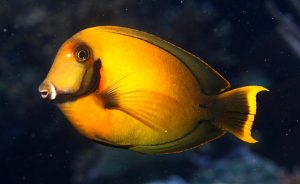
Mimic Tang, Acanthurus pyroferus: Also called the chocolate tang, these can reach a full size of just under 10 inches, and are called mimics because they mimic pygmy angels when young. Juveniles are yellow, and depending on where they live, they’re mimics of the lemonpeel (Centropyge flavissima), hearld’s (C. hearaldi), or Vroliki angel (C. vrolikii), which are less desirable prey for predators. They’re pretty for sure, and are usually relatively non-aggressive.
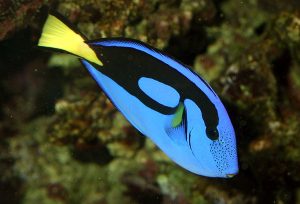
Pacific Blue Tang, Paracanthurus hepatus: Also known as the regal, palette, or hippo tang, these can get up to just over 12 inches in length, and are the weirdest acting of the tangs for sure. They’re usually very peaceful, but they have a strange habit of wedging themselves into crevices or just laying on their sides when it’s time to go to sleep. So, if you see one that looks like it’s gotten itself stuck, don’t worry. It’s just napping. Other than that, they can unfortunately be very shy/skittish at times, leading to the great frustration of many hobbyists. If you have to have one, try to spot one that is actually out and about, eating rather than trying to hide, and not to skinny.

Kole Tang, Ctenochaetus strigosus: Also known as the yellow-eye tang, these are another personal favorite, as they’re great algae-eaters but don’t get very big at all. Seven inches is about it for these, so they can fare better in smaller tanks with no problems. The only bad thing is that they’re also commonly (but not always) rather shy fishes, and skittishly dart around from hiding spot to hiding spot, sometimes taking months to calm down. They aren’t aggressive though, and the juveniles are yellow in color.
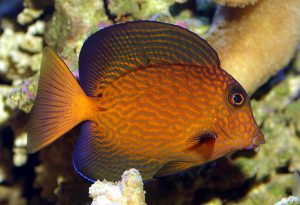
Chevron Tang, Ctenochaetus hawaiiensis: This is certainly a gorgeous fish when small, but they can reach a full size of 11 inches and end up looking quite drab. They just get darker and darker until they end up being dark brown with faint, lighter lines. While generally non-aggressive and hardy enough, they do get big, lose their looks, and are typically quite expensive, too.
And that’s it!
References
- Toonen, R. 2003. Nutritional Value of Live Foods for the Coral Reef Aquarium, Part 1. Advanced Aquarist Online Magazine: http://www.advancedaquarist.com/issues/dec2003/invert.htm
- FishBase Global Information System, undated. URL: www.fishbase.org
- Michael, S.W. 2001. Marine Fishes: 500+ Essential-to-Know Aquarium Species. T.F.H. Publications, Neptune, NJ. 447 pp.
- WetWebMedia, undated. URL: www.wetwebmedia.com


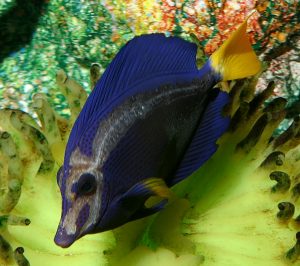




0 Comments